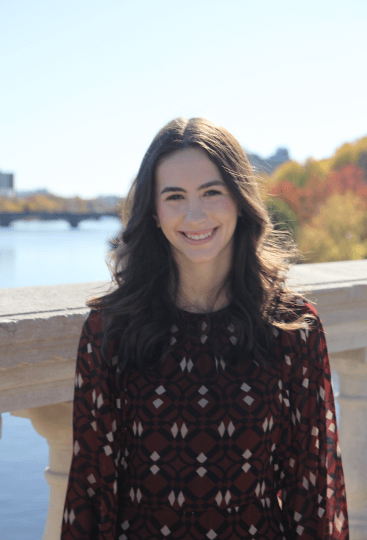Girls Who VC founder Isabella Mandis, a rising second-year studing computer science at SEAS.
Isabella Mandis discovered the world of venture capital (VC) through a friend at Stanford. Mandis, a rising second-year studying computer science at the Harvard John A. Paulson School of Engineering and Applied Sciences (SEAS), wanted to learn more about that world, so she started joining similar clubs here, such as The MBA Fund and Venture Capital Group. It didn’t take long for Mandis to recognize that not enough women were involved in VC.
“I loved working for female founders when I was younger, and I’m really passionate about supporting them,” Mandis said. “I wanted to build a community around women, which didn’t really exist.”
Mandis’ experience reflects a larger trend. Companies founded by women receive less than 3 percent of all VC investments, according to a recent article from the Harvard Business Review, and under 15 percent of all investors identify as women. Studies have shown women are more likely to invest in companies founded by women, so increasing the number of female venture capitalists could help counter these trends.
Mandis is trying to do this with “Girls Who VC,” an organization she founded at the start of this year. A mix of college students interested in VC and women already working in that field, the community fosters mentorship opportunities and guidance. The organization, which now has over 2,000 members, also produces podcasts, blog posts, newsletters, social media, mentorship, ambassador and scout programs to give aspiring venture capitalists hands-on experiences.
“I’ve always been really passionate about equity,” Mandis said. “A lot of my early responses from women working in the field said things like, ‘This is amazing, I wish I had this, how can I help?’ That made me realize that we don’t have enough women aspiring to be venture capitalists, but that’s a problem I can help solve.”
Girls Who VC began as a simple LinkedIn post last December, which included an interest form on the group’s website. Mandis then spent her winter break building the website, messaging numerous women about potentially joining. Along with established investors, Mandis also reached out to women in computer science or entrepreneurship clubs at other colleges, suggesting venture capital as a potential outlet for their interests. Mandis is a member of the Women in Computer Science club at SEAS. Girls Who VC is inspired by “Girls Who Code,” an international nonprofit organization she was part of in high school.
“I’ve always been passionate about technology and knew that was where I wanted to end up, especially emerging technologies,” she said. “Doing something people actually care about and want to join has been really cool.”
At first, Mandis produced all her organization’s content. She has since expanded her team to spread out some of the content-creation responsibilities, initially funding them through her Harvard Student Agencies job as a procurement manager at The Harvard Shop. She secured additional funding with a Spark Grant from the Harvard Innovation Labs.
“We have aspiring people who want to learn more about the field and know nothing about it,” she said. “We also have students in organizations that have exposed them to the field, and then we have women acting as mentors who are actually working in VC. I’m trying to cater to all of them, where people with more experience share what they’ve learned, and the people who know nothing can engage with introductory content.”
The organization has already produced positive results. Multiple members have taken on internships at VC funds they discovered through Girls Who VC, and Mandis said a female founder secured investment from a venture capitalist she met through the group. Mandis is hoping to scale up the club’s activities in the coming school year, including a potential in-person conference.
“The hardest thing is managing a team and making sure the content we produce is all at a level I’m proud of,” she said. “We want to make sure we’re helping as many people as we can without sacrificing the quality of the work we’re doing as we grow.”
Press Contact
Matt Goisman | mgoisman@g.harvard.edu
